Maths through story
This is a mathematical activity that works well with the story My cat likes to hide in boxes by Eve Sutton. It is a measure, shape and space activity for nursery and reception aged children.
You will need:
• a selection of toy cats (small, large, furry, smooth etc)
• a selection of paper and card
• a selection of glues and sticky tape for sticking the paper together.
Read the story to the children. You may wish to leave out some parts of the text (which are repeated) for the children to complete.
Look at and compare the toy cats, look for similarities and differences.
• small cats
• large cats
• long cats
• short cats
• furry cats
• coloured cats
• cats with the longest whiskers
• cats with the shortest whiskers
• cats with the longest tails
• cats with the shortest tails
If the children want to they can work in pairs, however, in my experience, most children want a cat of their very own to work with.
Ask the children to choose a cat and design a box for it.
The task is to make a box, here are the requirements:
• It has to hold the toy cat they have chosen.
• The box must not squash the cat, as he would be an unhappy cat.
• The box must not have too much space so that when the box is moved he gets hurt by sliding from one side to the other.
• The box must have a lid (use a fold as a hinge or make a hinge with sticky tape).
Encourage the children to select paper or card appropriate to the size of their cat. They can compare the cat to the paper by placing it on top of the paper. You may wish to encourage the use of non standard measures and ask them to find a piece of paper three pencils long to make their box.
Encourage the use of mathematical vocabulary:
Big, bigger, biggest, small, smaller, smallest, tall, taller, tallest, short, shorter, shortest, long, longer, longest, on top of, beneath, under, over, position, above, below, top, bottom, side, on, in, outside, inside, around, in front, behind, front, back, before, after, beside, next to, opposite, apart, between, middle, edge, corner, length, width, height, depth, long short, high, low, wide, narrow, deep, shallow, etc.
Ask the children to test their boxes against the requirements at the beginning of the lesson and if necessary refine their box.
• It has to hold the cat they have chosen.
• The box must not squash the cat.
• The box must not have too much space so that the cat slides about.
• The box must have a lid.
Cats and their boxes make a great display.
Liz Gibbs is a freelance national and international teaching and learning consultant for mathematics and ICT. This autumn Liz is currently running courses in Suffolk, London and Hong Kong. You can find out more by visiting her website. www.thebusylizzie.co.uk
Popular Teaching Resources
Stay Up To Date
Sign up for our newsletter and we’ll let you know when we create new early years resources.





